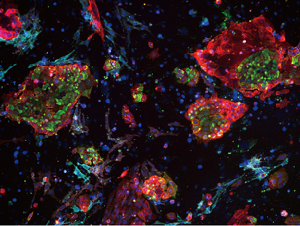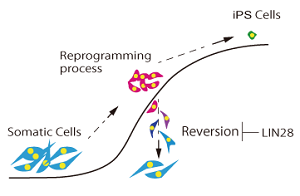
News & Events
News & Events
Home › News & Events › 2013 › Research › Identifying one of the obstacles to the creation of human iPS cells
News
July 09, 2013
Identifying one of the obstacles to the creation of human iPS cells
In a detailed study of the human cell reprogramming process, a group including CiRA researcher Tsuyoshi Tanabe, lecturer Kazutoshi Takahashi, and Professor Shinya Yamanaka has demonstrated that a major obstacle to the creation of iPS cells1 lies in the maturation stage of the reprogramming2 process. The group also found that LIN283 improves iPS cell induction efficiency by promoting maturation in the reprogramming process. The scientific paper was published in the June 24 online version of the U.S scientific journal PNAS.
iPS cells can be generated by inducing in somatic cells the expression of four reprogramming factors (OCT3/4, SOX2, KLF4, and c-MYC: OSKM), but the iPS cell production efficiency has been found to be very low at 0.2% or less. In the search for an explanation, it has not yet been clearly established whether reprogramming is initiated in a large number of cells, or in only a very limited number of cells.
In the present study, it was found that cells in which reprogramming had been initiated displayed specific expression of a surface antigen known as TRA-1-60. This antigen was then used as an indicator to quantify the time course of reprogramming efficiency. The results showed that somatic cell reprogramming is initiated in a large proportion (12-24%) of cells into which reprogramming factors are introduced. However, the success rate of complete reprogramming to ultimately create iPS cells is only around 0.2%, which led the researchers to hypothesize that it was not the initiation of reprogramming, but a later-stage process, that was the obstacle. A detailed analysis of TRA-1-60-positive cells indicated that 75% or more of cells had reverted to their state as of before the initiation of reprogramming and thus failed to become iPS cells. It was also found that, LIN28, which is known to improve reprogramming efficiency, prevents this reversion to the somatic cell state and improves iPS cell generation efficiency.
The findings of this research elucidated an important area of the mechanism behind the low success rate of iPS cell generation and suggested that stimulating the maturation rather than the initiation of reprogramming is the key to efficient iPS cell generation. Going forward, the search for factors and compounds to stimulate the maturation process can be expected to further boost efficiency.

Fig. 1
Photograph showing cells in which reprogramming has been initiated but which are beginning to revert to their state prior to the initiation of reprogramming.
The green cells are those which have been reprogrammed and are on the way to becoming iPS cells. The red cells are those where reprogramming has been initiated but which are now reverting to their pre-reprogramming state. Blue cells are those where the reversion process is further advanced.

Fig. 2
Model diagram illustrating the reprogramming process. Reprogramming is successfully initiated in many cells by the four reprogramming factors. However, the process fails in the large majority of cells, which revert to their pre-reprogramming state. This results in a very low iPS cell generation efficiency. By preventing this reversion, LIN28 improves iPS cell generation efficiency.
Title of Paper
"Maturation, not initiation, is the major roadblock during reprogramming toward pluripotency from human fibroblasts"
Authors
Koji Tanabea, Michiko Nakamuraa, Megumi Naritaa, Kazutoshi Takahashia, and Shinya Yamanakaa,b
Affiliated Institution
a. Department of Reprogramming Science, Center for iPS Cell Research and Application, Kyoto University, Kyoto, 606-8507, Japan
b. Gladstone Institute of Cardiovascular Disease, San Francisco, CA 94158
1) iPS cells
iPS cell: induced pluripotent stem cell. Similar to ES (embryonic stem) cells, iPS cells are pluripotent stem cells artificially generated by introducing reprogramming factors into somatic cells. They were first successfully produced in 2006 from mouse somatic cells in research carried out by CiRA's Professor Shinya Yamanaka.
2) Reprogramming
The process of 'resetting' the nucleus of a differentiated somatic cell to return it to the state of a nucleus at the initial stage of cell development, like that of a fertilized egg, after which the cell can be turned into a pluripotent stem cell or other cell type.
3) LIN28
A reprogramming factor which is one of the genes specifically expressed in human ES cells. A research group led by Professor James Thomson has succeeded in generating human iPS cells using a group of factors including LIN28: OCT3/4, SOX2, NANOG, and LIN28.






















